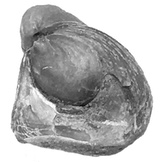Application to Outcrops
Applying sequence stratigraphy to outcrops typically follows from the smallest-scale interpretations to the largest. The first step in this approach is to interpret individual beds in terms of depositional events, including an evaluation of the shear stress in the environment, the type of flow (currents, waves, tides, combined flow), bioturbation and trace fossils, etc. This information is critical for the next step, to recognize bedsets, that is groups of beds that record similar depositional processes, and to interpret those bedsets as facies, the records of specifics depositional environments. These steps are crucial because errors at this point often cause errors in interpretations of relative depth, which in turn affects the recognition of parasequences and stacking patterns. Solid facies work is essential for a solid sequence-stratigraphic analysis.

From the vertical successions of bedsets, gradational bedset boundaries and sharp bedset boundaries should be identified. Gradational ones generally indicate a Waltherian contact, that is, the adjoining bedsets were deposited in laterally adjacent environments. Sharp bedset boundaries should be examined carefully to determine whether they are flooding surfaces (deeper-water facies abruptly overlying shallow-water facies) or potential surfaces of forced regression (shallow-water facies abruptly overlying deeper-water facies). For many of these, intervening facies may be absent, such as offshore directly overlying upper shoreface, with lower shoreface and transition zone missing. Flooding surfaces are then used to define the parasequences between them, and surfaces of forced regression are used to define high-frequency sequences.
Progressive trends in water depth are then used to define sets of parasequences, with upward shallowing indicating progradational stacking, upward deepening indicating retrogradational stacking, and a lack of a net trend in water depth indicating aggradational stacking. Degradational stacking is usually characterized by one or more units bounded by surfaces of forced regression that collectively display upward shallowing. Degradational stacking usually allows displays a ‘telescoped’ section, where the upward shallowing is accomplished over a much shorter stratigraphic interval than the same change in facies would be in progradational stacking.
Potential sequence boundaries should be identified by recognition of subaerial unconformities. These may be characterized by channelized erosional surfaces, sometimes with relatively high relief of meters to tens of meters, regional erosional surfaces that bevel underlying strata, as well as anomalous well-drained paleosols. Often, subaerial unconformities are overlain by a lag of coarse siliciclastic gravel. In some cases, evidence of subaerial exposure was removed by subsequent transgression, complicating the identification of a sequence boundary, although such sequence boundaries typically coincide with the onset of retrogradational stacking.
Potential condensed sections should be recognized on the basis of unusual burrowed surfaces, abundant diagenetic materials, fossil concentrations, closely spaced bentonite beds, or radioactive shales. Condensed sections typically coincide with one or more of the major flooding surfaces in the interval of retrogradational stacking. Often, but not always, the best-developed condensed section lies at the maximum flooding surface marking the turnaround from retrogradational stacking to progradational stacking.
From the recognition of parasequence sets, subaerial unconformities, and condensed sections, systems tracts (LST, TST, HST, FSST) can be identified based on their stacking pattern and position within a sequence. In addition, major stratal surfaces can also be identified, specifically the sequence boundary, transgressive surface (maximum regressive surface), maximum flooding surface, and basal surface of forced regression.
It is important to stress that not all of these surfaces or systems tracts may be present within any given sequence in an outcrop. The absence of one or more surfaces or systems tracts may provide important clues as to the relative position of the outcrop within the basin. For example, falling-stage and lowstand systems tracts are commonly absent in updip areas where the transgressive surface and sequence boundary are merged as one surface. In such areas, significant portions of the highstand systems tract may have eroded away and the sequence boundary is marked by the beginning of retrogradational stacking. In downdip areas, the transgressive and highstand systems tracts may be thin and mud-rich, whereas the lowstand systems tract may be characterized by the abrupt appearance of thick sandy facies. Many more variations are possible and many basins are characterized by a typical pattern of sequence architecture.

